

The development of wearable electronic equipment, inspection and testing, and soft robotics technology requires strain sensors to have high sensitivity, scalability, adherence to arbitrarily complex surfaces, and preferably self-healing. Conductive hydrogels are promising as sensing materials for these applications. However, their sensitivity is generally low and suffers from signal hysteresis and fluctuations due to their viscoelasticity, which can impair their sensing performance. This paper reports a hydrogel composite material incorporating MXene, and its performance is better than all previously reported hydrogel strain sensors. The resulting composite hydrogel [MXene-based hydrogel (M-hydrogel)] has a tensile strain sensitivity of 25, which is 10 times higher than that of the original hydrogel. In addition, M-hydrogel shows excellent stretchability of more than 3400%, instantaneous self-healing ability, excellent compliance, and adhesion to various surfaces including human skin. The M-hydrogel composite shows higher sensitivity under compressive strain (GF=80) than under tensile strain. The authors use this combination of asymmetric strain sensitivity and viscous deformation (self-healing residual deformation) to add a new dimension to the hydrogels sensing capabilities. Therefore, the direction and speed of movement on the surface of the hydrogel can be easily detected. Based on this effect, M-hydrogel shows excellent sensing performance in advanced sensing applications. Therefore, the traditionally unfavorable viscoelastic properties of hydrogels can be converted into sensing advantages, which reveals the prospect of hydrogel sensors.
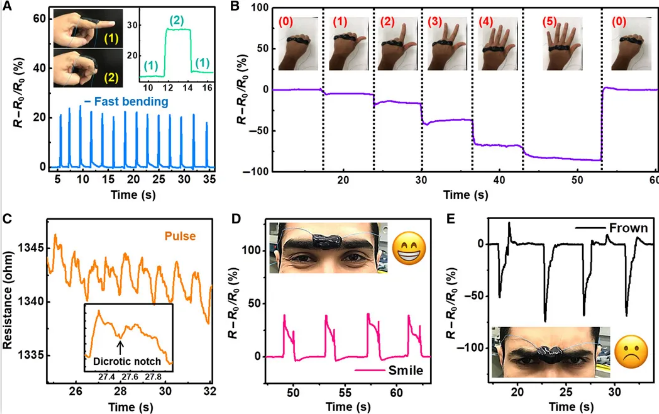
Figure 1 General sensing performance of MXene-hydrogel
MXenes stretch hydrogel sensor performance to new limits.
Science Advances (IF 13.116)
Pub Date: 2018-Jun-01
DOI: 10.1126/sciadv.aat0098

Microelectronic devices that can be installed on human skin have aroused widespread interest, including various promising applications such as man-machine interfaces, bio-integrated equipment, and personalized medicine. However, in the entire scope of work, the development of an electronic skin that mimics the bodys somatosensory system is still a severe challenge. This paper reports a multifunctional electronic skin device with a heterogeneous structure. The device has high toughness and low hysteresis at the interface through polypyrrole nanowires (PPy NWs) while controlling the generation and distribution of cracks. The multi-dimensional configuration enables the electronic skin to have a large working range (2800%), ultra-fast response time (90 ms) and rebound time (240 ms), good linearity (800%), adjustable sensing mechanism and excellent The reproducibility. At the same time, the electronic skin can detect, quantify and remotely monitor stretching motion, tactile pressure, proximity sensing, and temperature and light changes in multiple dimensions, thereby establishing a promising platform for the next generation of smart flexible electronic products.
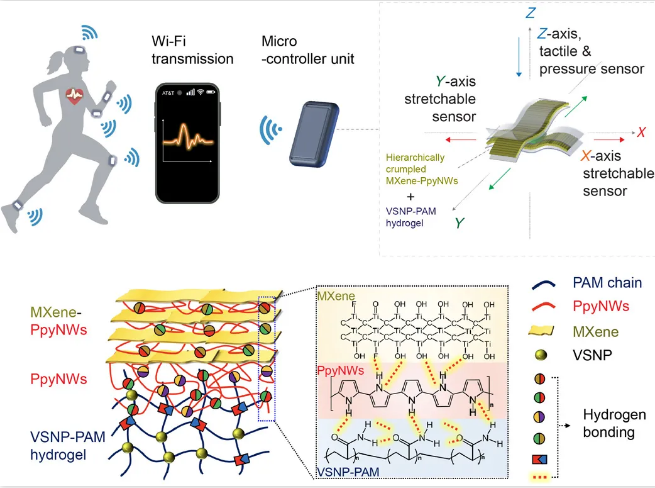
Figure 1 Schematic diagram of the heterogeneous integrated electronic skin of MXene-PPyNW-VSNP-PAM.
Mixed-dimensional MXene-hydrogel heterostructures for electronic skin sensors with ultrabroad working range
Science Advances (IF 13.116)
Pub Date: 2020-11-27
DOI: 10.1126/sciadv.abb5367

Conductive hydrogel, due to its great potential in electronic skin and personalized medicine, and as a flexible wearable strain sensor has attracted great research interest. However, conventional conductive hydrogels using pure water as a dispersion medium will inevitably freeze below zero, resulting in a decrease in electrical conductivity and mechanical properties. At the same time, even at room temperature, this hydrogel will inevitably lose water due to evaporation, resulting in a poor shelf life. In this paper, an antifreeze, self-repairing and conductive MXene nanocomposite organic hydrogel (MNOH) is developed. The MXene nanocomposite hydrogel (MNH) is immersed in an ethylene glycol (EG) solution to replace part of the water molecules. MNH was prepared by incorporating a network of conductive MXene nanosheets into a hydrogel polymer network. The prepared MNOH has excellent frost resistance (−40°C), long-lasting moisture retention (8d), excellent self-healing ability and excellent mechanical properties. In addition, the MNOH can be assembled as a wearable strain sensor, which can detect human physiological activities with a relatively wide strain range (up to 350% strain) and a high specification factor of 44.85 at extremely low temperatures. This work paved the way for potential applications in electronic skin, human-computer interaction, and personalized healthcare monitoring.
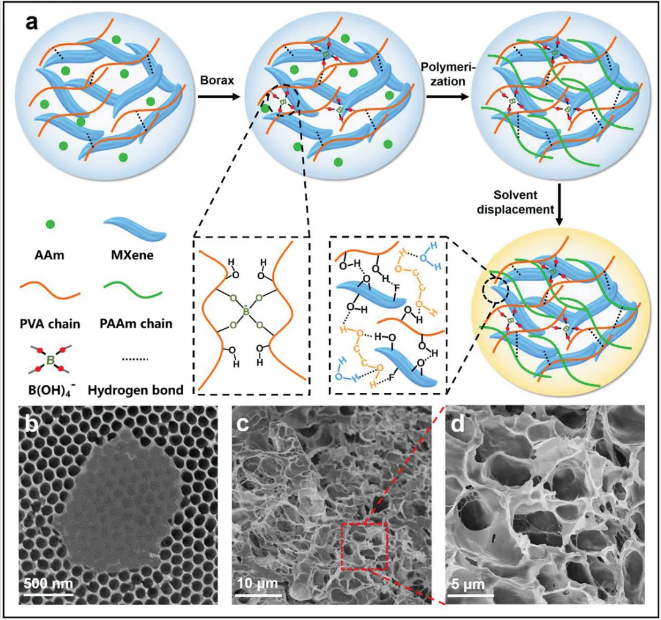
a) Schematic diagram of preparation of conductive, antifreeze and self-repairing MNOH.
b) SEM images of layered MXene nanosheets and c, d) freeze-dried MNH.
Conductive MXene Nanocomposite Organohydrogel for Flexible, Healable, Low-Temperature Tolerant Strain Sensors
Advanced Functional Materials (IF 16.836)
Pub Date: 2019-07-26
DOI: 10.1002/adfm.201904507

In bioelectronics, conductive hydrogel is an ideal material for human-computer interaction. However, the freezing problem caused by low temperature and the structural damage caused by water evaporation severely hinder their practical application. In order to solve these problems, this paper introduces high-conductivity MXene nanosheets into the tannic acid modified cellulose nanofibril/polyacrylamide hybrid gel network through careful design, and successfully prepared MXene-based conductive organic hydrogel , The network is permeated with glycerol (Gly)/water binary solvent. Due to the introduction of Gly, the prepared organic hydrogel exhibits excellent flexibility and conductivity in a wide temperature range (-36 to 60°C), and exhibits long-term stability in an open environment (> 7 days). In addition, dynamic catechol borate bonds and hydrogen bonds between water and Gly molecules are easily formed, which further makes organic hydrogels have excellent stretchability (about 1500% strain), high tissue adhesion and self-healing characteristic. Good environmental stability and wide working strain range (approximately 500% strain); coupled with high sensitivity (instrument coefficient of 8.21), this organic hydrogel becomes an ideal material for large and small motion monitoring.
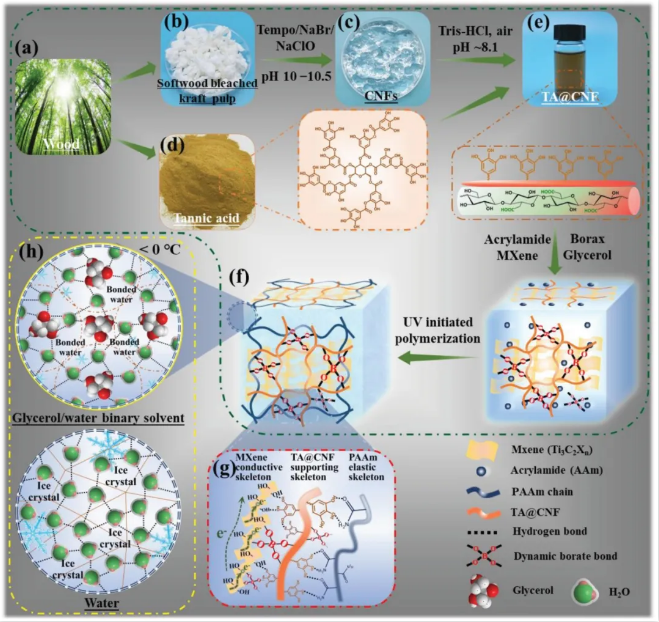
a-e) Schematic diagram of the preparation of TA@CNF.
f) Schematic diagram of the formation of TA@CNF/PAAm/MXene interpenetrating network in organic hydrogel.
g) Schematic diagram of the chemical bonding between MXene, TA@CNF and PAAm elastic network.
h) Schematic diagram of the bonding structure of water molecules in organic hydrogel (upward) and conventional hydrogel (downward) at sub-zero temperature.
MXene-Based Conductive Organohydrogels with Long-Term Environmental Stability and Multifunctionality
Advanced Functional Materials (IF 16.836)
Pub Date: 2020-09-18
DOI: 10.1002/adfm.202005135

Due to the potential applications of hydrogels in flexible electronics, human-machine interfaces, sensors, actuators, and flexible energy storage, they have recently attracted great interest. Thanks to its excellent combination of hydrophilicity, metallic conductivity, high aspect ratio morphology, and widely adjustable properties, when two-dimensional MXenes are incorporated into hydrogel systems, they provide exciting and versatile MXene-based soft material. The fascinating properties of MXene hydrogels are dominated by the complex gel structure and gel action, which requires in-depth research at the nanometer level. On the other hand, formulating MXenes into hydrogels can significantly improve the stability of MXenes, which is usually a limiting factor for many MXene-based applications. In addition, through simple processing, derivatives of MXene hydrogels, such as aerogels, can be obtained, thereby further expanding its versatility. This article aims to demonstrate the great potential of MXene hydrogels in expanding the application range of hydrogels and MXene, and improving the performance of MXene-based devices. The author clarified the existing structures of various MXene-containing hydrogel systems, as well as their gelation mechanism and the driving force for their interconnection. Then, the author discussed the unique properties produced by the integration of MXene into hydrogels. Compared with using MXenes or hydrogels alone, they are used in many applications (energy storage/harvesting, biomedicine, catalysis, electromagnetic interference shielding and transmission). Sense) has enhanced performance.
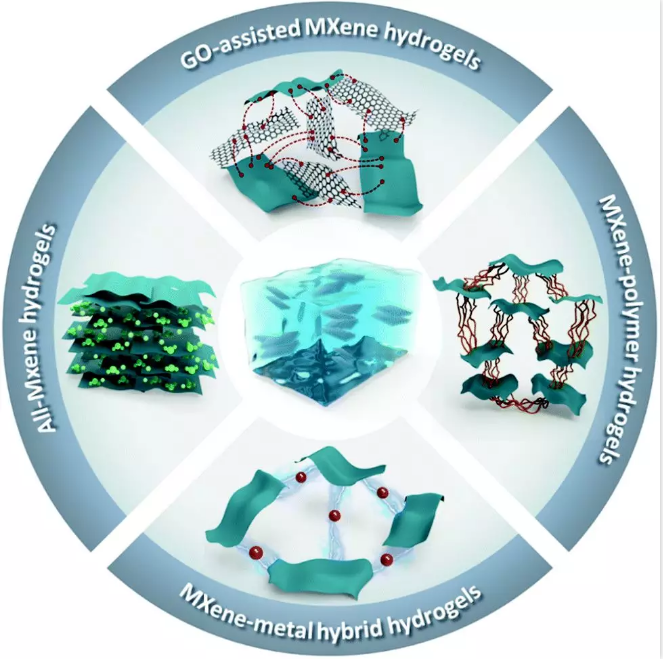
Figure 1 is a schematic diagram of the MXene-containing hydrogel reported.
Clockwise: full MXene, GO assisted MXene, MXene-polymer and MXene-metal hybrid nanocomposite hydrogel.
MXene hydrogels: fundamentals and applications.
Chemical Society Reviews (IF 42.846)
Pub Date: 2020-09-16,
DOI: 10.1039/d0cs00022a

The rapid development of terahertz technology requires high-performance electromagnetic interference (EMI) shielding materials to create a safe electromagnetic environment. Although a great breakthrough has been made in achieving excellent shielding efficiency (SE), traditional shielding materials still have high reflectivity and cannot be readjusted or recycled once formed, resulting in harmful secondary electromagnetic pollution and poor adaptability . This article reports a strategy that assembles MXene nanosheets through a biomineralization-inspired assembly method to produce a hydrogel type with a hybrid structure composed of MXene, polyacrylic acid (PAA), and amorphous calcium carbonate (ACC) Shielding material (MXene-PAA-ACC). The prepared MXene composite hydrogel has moderate electrical conductivity, excellent stretchability and recyclability, good shape adaptability and adhesion to various surfaces, as well as rapid self-repairing ability, making it more Functionality, great application flexibility and reliability. More importantly, thanks to the combination of porous structure, moderate electrical conductivity derived from the MXene network and internal water-rich environment, the hydrogel exhibits absorption-based EMI shielding performance. In an extremely thin hydrogel (0.13mm), high EMISE of 45.3dB, excellent reduction loss (RL) of 23.2dB and effective wide absorption bandwidth (EAB, 0.2-2.0THz) can be achieved simultaneously. In addition, the sensing properties of multifunctional hydrogels were also studied.
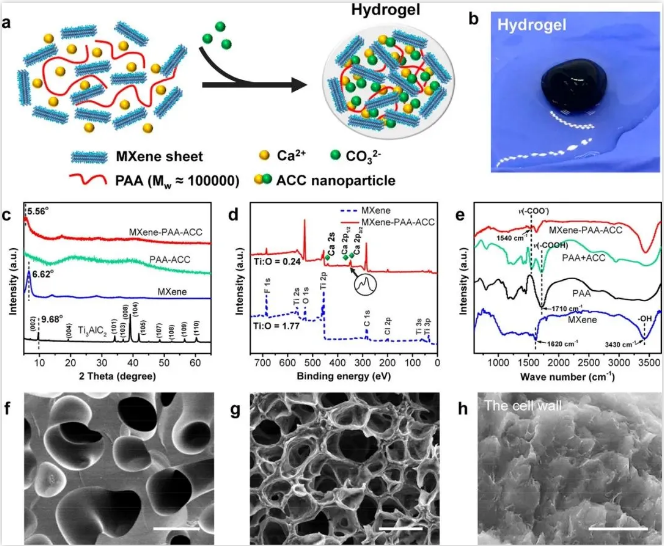
Figure 1. Preparation and structural characterization of MXene composite hydrogel.
(A) Schematic diagram of the preparation of MXene composite hydrogel.
(B) Photograph of the synthesized MXene composite hydrogel.
(C) X-ray diffraction (d) XPS investigation and (e) FT-IR spectra of MXene hydrogel and reference samples.
(F) SEM images of PAA-ACC hydrogel and (g, h) MXene composite hydrogel.
Multifunctional MXene Composite Hydrogels with Strain Sensitivity toward Absorption-Dominated Electromagnetic-Interference Shielding
ACS Nano (IF 14.588)
Pub Date: 2021-01-05
DOI: 10.1021/acsnano.0c08830

The re-stacking of 2D MXene nanosheets severely limits their applications, and the development of effective strategies to overcome this problem remains challenging. For the first time, a MXene/polyacrylic acid (PAA) hydrogel with super stretchability (~1400%), conductivity and anti-agglomeration has been produced in this article. In this strategy, in-situ growth of TiO2 nanoparticles (NPs) on the surface of MXene was used to overcome the re-stacking of nanosheets in aqueous solvents. The reducing TiO2@MXene nanosheets not only catalyze the dissociation of ammonium persulfate to initiate the ultra-fast polymerization of AA monomer without the help of thermal energy, but also can form a crosslinked polymer chain (through chemical bonding) in a short time Hydrogels. The chemical bond between TiO2@MXene nanosheets and AA solves the problem of MXene deposition in the gel system, so that the hydrogel has significant stability (>60 days). In addition, the mechanical, adhesive, swelling and conductive properties of TiO2@MXene-PAA hydrogel can be easily adjusted by changing the content of TiO2@MXene. The viscous and conductive TiO2@MXene-PAA hydrogel can be used as a self-adhesive bioelectrode to stably receive human physiological signals, including electrocardiogram (ECG), electrooculogram (EOG) and surface electromyography (sEMG). This strategy greatly reduces the aggregation of MXene nanosheets in the hydrogel and improves its stretchability. In addition, this strategy has broad prospects for bioelectronic applications based on MXene-based stretchable hydrogels.
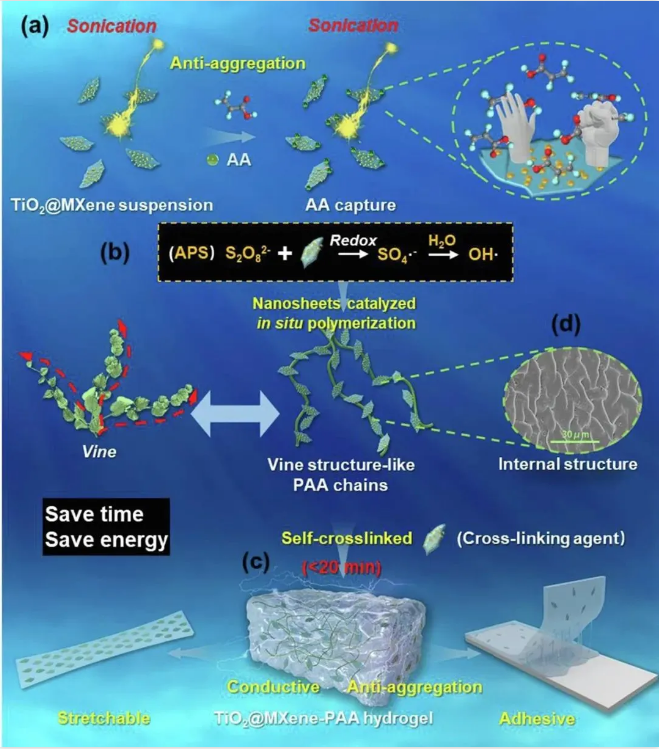
Figure 1. (a) AA monomer captured by the surface of TiO2@MXene nanosheets under ultrasound excitation;
(B) Rapid synthesis of rattan structure PAA catalyzed by TiO2@MXene nanosheets;
(C) Self-assembly and self-crosslinking behavior of PAA chains with TiO2 @ MXene nanosheets (crosslinking agent);
(D) SEM image of the internal structure of TiO2 @ MXene-PAA hydrogel.
Modified Ti3C2TX (MXene) Nanosheet-Catalyzed Self-Assembled, Anti-Aggregated, Ultra-stretchable, Conductive Hydrogels for Wearable Bioelec
tronics
Chemical Engineering Journal (IF=10.652)
Pub Date: 2020-07-02
DOI: 10.1016/j.cej.2020.126129

Electronic skin has functions similar to human skin (stretchability, self-repair and multi-functional sensory), and has potential applications in personalized medicine, artificial intelligence equipment, and soft robotic systems. Among a variety of soft sensors used in electronic skin, strain sensors are crucial, as they can convert mechanical stimuli into readable signals. Strain sensors can be divided into piezoresistive, capacitive and piezoelectric. Piezoresistive and piezoelectric strain sensors have high sensitivity, but capacitive sensors have low hysteresis, extraordinary stability and high linearity, which are ideal in practical applications, such as blink monitoring, pulse detection and human movement Monitoring covers both small and large strain ranges. In this research, a self-healing MXene/PVA hydrogel-based electrode was used to develop a capacitive strain sensor with high stretchability, high linearity and small hysteresis. Therefore, MXene is used as a nanofiller incorporated into PVA hydrogel: (1) Enhance the electrical conductivity of the hydrogel. (2) Mixing with PVA improves self-healing. MXene/PVA hydrogel is prepared by directly mixing MXene flakes with a homogeneous PVA solution, and adding a borate solution to complete the gelatinization. The synthesized MXene/PVA hydrogel has the breaking elongation (≈1200%), rapid self-healing ability (≈0.15s) and excellent electrical conductivity than CNT/PVA hydrogel. Using MXene/PVA hydrogel as the electrode, and using the VHB membrane (4905, 3M) as the dielectric layer, the capacitive strain sensor was assembled into a sandwich structure. The capacitive sensor based on MXene/PVA has good linearity, self-healing and high mechanical durability (relative capacitance change after 10,000 cycles is reduced by 5.8%), and the gauge factor (GF) is about Is 0.4%. High performance enables the device to detect external stimuli (such as joint movement and vocalization), and demonstrate its potential application value in electronic skin.
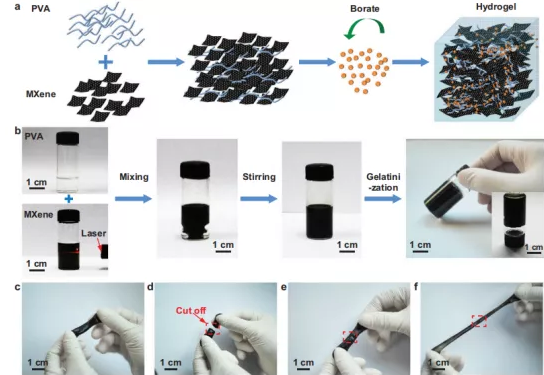
Figure 1. Preparation of MXene/PVA hydrogel.
a) Schematic diagram of the synthesis of MXene/PVA hydrogel.
b) The photo of the preparation process of MXene/PVA hydrogel.
c-f) Photos of self-healing and stretchability of the prepared MXene/PVA hydrogel.
Highly Stretchable and Self-Healable MXene/Polyvinyl Alcohol Hydrogel Electrode for Wearable Capacitive Electronic Skin
Advanced Electronic Materials (IF 6.593)
Pub Date: 2019-05-23
DOI: 10.1002/aelm.201900285

In recent years, electronic skin has attracted widespread attention because of its stretchability and sensing performance similar to human skin. Among them, flexible strain sensors that can convert physiological signals into electrical signals have shown great potential in flexible touch screens, health clinical monitoring, and industrial robots. However, the limited tensile properties and low sensitivity severely hinder their practical application in flexible strain sensors. Hydrogel is a three-dimensional network containing a large amount of water or ionic liquid. It is widely used in flexible strain sensors due to its excellent stretchability, flexibility and biocompatibility. However, due to the limited degree of crosslinking and high viscosity, the mechanical properties and stability of single-network hydrogels are relatively poor, and the preparation of flexible wearable stress sensors with both high stretchability and high sensitivity still faces great challenges. The author added the two-dimensional conductive material MXene to the PVA/PVP dual-network hydrogel, and successfully constructed a highly sensitive MXene composite dual-network hydrogel sensor with excellent mechanical properties. The sensor can realize real-time monitoring of various physiological stimuli of human activities, such as knee bending, finger bending, pulse beating, voice, pulse vibration, and health diagnosis. It can also be further assembled into a complex matrix of pressure sensors. Interaction, health diagnosis and wearable electronic devices have good application prospects.
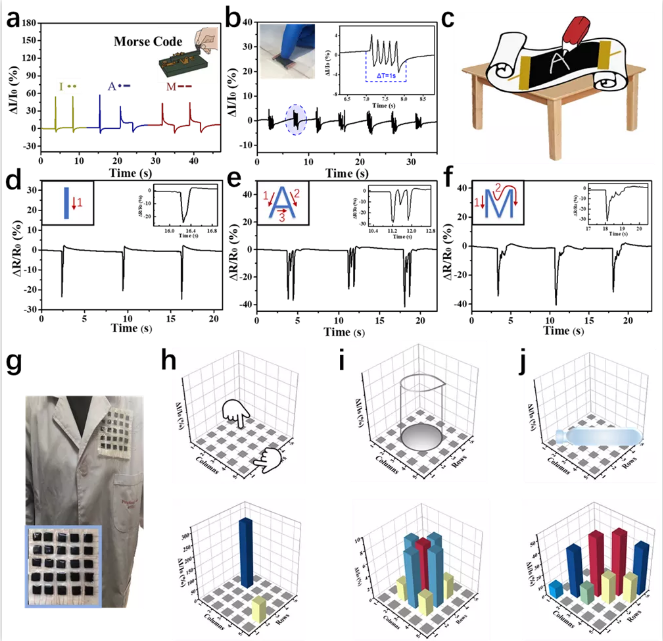
Figure 1 Application of pressure sensor
Highly Stretchable, Elastic, and Sensitive MXene-Based Hydrogel for Flexible Strain and Pressure Sensors.
Research
Pub Date: 2020-07-14
DOI: 10.34133/2020/2038560
Information source: scientific research
This information is from the Internet for academic exchanges. If there is any infringement, please contact us and delete it immediately




















